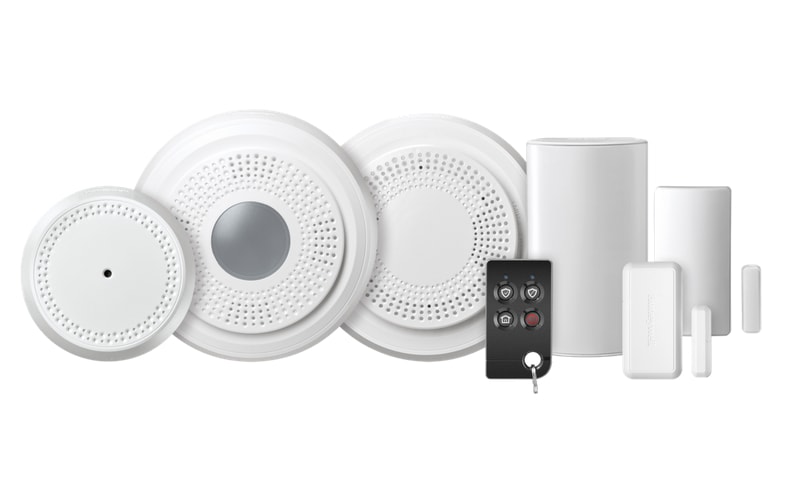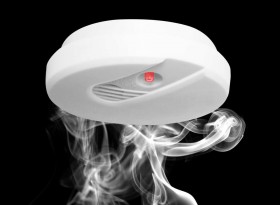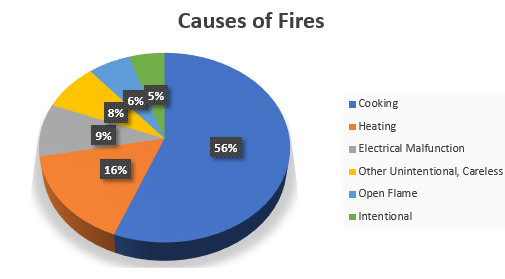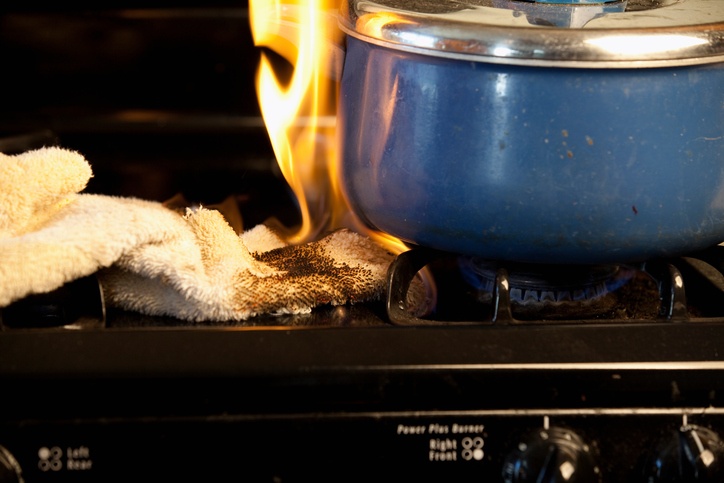Last Updated on March 4, 2022 by Alarm New England
While we have made significant progress over the years in educating people about fire prevention and taking precautions in the home, it’s striking to see the following statistics.
In 2015, the National Fire Protection Association reported that:
- One home structure fire was reported every 86 seconds.
- One civilian fire injury was reported every 34 minutes.
- One civilian fire death occurred every 2 hours and 40 minutes.
In fact, the National Fire Protection Association (NFPA) reported there were 1,345,500 fires in the United States in 2015 alone. These fires caused 3,280 civilian deaths, 15,700 civilian injuries, and $14.3 billion in property damage.
The state of Massachusetts has recently increased its efforts in fire prevention by providing grants to 234 community fire departments for fire safety training to school children and senior citizens. Due to education efforts such as the SAFE program in Haverhill, the number of children who die in fires every year in Mass has decreased by 70% in the past few decades.

6 Suggestions for Keeping Your Home and Family Safe from Fire
- Talk with all family members about a fire escape plan and practice the plan twice a year.
- Annual maintenance for both wood burning and gas fireplaces is essential to ensure that no latent fire hazards are present.
- If you own a gas fireplace, a safety screen is an essential safety element as they protect your pets and children from contact with hot glass and metal.
- Do not burn candles near curtains, and other flammable objects.
- Test your home safety devices, including carbon monoxide detectors and smoke alarms for functionality and battery life.
- Install smoke alarms as part of a monitored fire detection system on every level of your home, and especially inside bedrooms and outside sleeping areas.
Home Automation
As technology continues to advance incorporating all of your home monitoring systems into the palm of your hand. Smoke and fire detectors are an essential part of your home or apartment safe. Loud, piercing alarms should wake you if there’s a problem, so you and your loved ones can safely escape. Smart smoke detectors go a step further, as they can send an alert to your smartphone. If you’re at work, or out of town, you can call the fire department or have a neighbor check on your house, to see if everything is OK. Another benefit of a smart smoke detector is that you can temporarily silence the alarm from your smartphone — so there’s no more trying to jab the Silence button with a broomstick after you set it off while cooking.
Understanding Your Town’s Fire Code
Having worked out in the field as both a service and installation technician, I can lend some insight on how fire code works.
If you are ever going to sell your property, you are going to need to bring it up to code. Rather than wait until you are going to sell your home, it makes sense to do it ensure it is up to code while you are living there to help keep you and your family safe.
The good new is that, if your town’s fire code requirements can be found online, it is a much more cost-effective endeavor than is used to be. Be sure to double check the fire code in your town, but these guidelines will help you to start thinking about it.
Start by counting how many smoke detectors are located within your property and note each location.
Today’s code requires that you have:
- (1) smoke detector per floor or (1) smoke detector per 1200 square feet of living space.
- Massachusetts also requires (1) smoke detector within each bedroom.
- Carbon Monoxide detection is also required per code. Since 2006, carbon monoxide detectors are required in the following formation: (1) per floor and (1) within 10 feet of every bedroom.
It’s possible that your current fire and carbon monoxide monitoring system may not be up to these code. That’s because some homes were was “grandfathered” into the new regulations.
We can bring it up to code by simply replacing existing smokes detectors with our new top of the line Honeywell wireless devices. We will then map out the additional smoke detectors you need to meet your town’s fire code. An added benefit is that this could also lead to some discounts on your homeowner’s insurance.

Depending on when your house was built or modified you can fall under different sets of guidelines and regulations. Code varies from state to state, and sometimes even county to county within a state itself.
Always reach out to your local fire department and see if what is listed above meets the code requirement in your state and county.
Important Sensors to Protect Your Home
Technology has come a long way. Today, there are a variety of new sensors and improved technology that was not available to homeowners years ago.
Low Temperature Sensor
These sleek, small devices monitor the temperature and when the building drops below 42 degrees it sends in a notification to our UL listed Central Monitoring Station. These are especially important for a property that is often empty, like a second home, to help prevent a burst pipe.

If you have ever had a burst pipe, you may be shivering remembering the experience. This past winter we experienced temperatures as low as -10 degrees on the Cape. I called a few friends of mine who are licensed plumbers and they reported that last winter they responded to hundreds of calls about frozen pipes and dead furnaces.
I also asked a union-licensed plumber what the average cost is to repair busted or frozen pipes and he said the cost ranges from about $400 dollars to fix for a minor burst and close to $1500 if for a larger incident because it often also include both plumbing and patch work. That cost does not even take into consideration the cost of mitigating the flood damage.
This spend could have easily be prevented with a nominal additional equipment spend and zero additional monthly monitoring. At Alarm New England, we sell motion detectors with low temp sensors already built in to provide this value at no additional cost to our customers.
Flood Sensor
I can speak from experience that this device can be a huge headache-saver. You simply install the device near some valuables you don’t want to get wet. I usually install them in areas prone for flood: close to a hot water tank, near a sump pump and underneath bath/kitchen sinks.

I recently had some flooding in my basement but, thanks to the flood sensor, was alerted quickly and was able to move some valuables out of the area instead of sleeping through another 4 hours of flooding. This saved me the cost of replacement goods. It also gave me a heads-up that my basement needed some preventative patch work. Early detection means huge potential savings.
Fire and Carbon Monoxide Sensors
Roughly 400 Americans die from unintentional CO2 poisoning each year. There are 20,000 visit emergency rooms for small cases and more than 4,000 of those require hospitalization.
People often overlook adding smoke and CO2 detectors to new alarm systems because they already have hard-wired systems in place. Hard-wired devices are required by building code and a great basic line of defense. Where they fall short, however, is if they are activated when no one is home. By tying them into monitored alarm systems, our central monitoring station is watching them 24 hours a day, so if you’re not home, we will be alerted and can quickly notify you and dispatch the authorities.

According to the NFPA (National Fire Protection Association), deaths from fires in which no smoke alarms were present or in which smoke alarms were present but did not operate, accounted for 60 percent of all home fire deaths.
Smoke alarms were lacking in 37 percent of home fire deaths. At least one alarm was present but non-operational in 23 percent. I know when I was growing up, if a smoke detector started to chirp, my parents would pull it off the ceiling, take the battery out and put it in a drawer somewhere until they were able to put a new battery in it.
Keep a stash of the appropriate batteries handy so you do not make this potentially fatal mistake. Also make sure to test smoke alarms at least once a month. Replace any smoke alarm that is more than 10 years old. Smoke detectors older than 10 years start to lose sensitivity and can provide you and your family with a false sense of protection.
A Few Final Tips
Based on my years of experience as a technician, I have compiled some fire safety tips that you can implement immediately:
- Watch your cooking: Stay in the kitchen when you are frying, grilling, or broiling food. If you must leave, even for a short time, turn off the stove. If you are simmering, baking, roasting, or boiling food, check it regularly, remain in the home while food is cooking, and use a timer.

- Give space heaters space: Keep fixed and portable space heaters at least three feet from anything that can burn. Turn off heaters when you leave the room or go to sleep.
- Smoke outside: Ask smokers to smoke outside. Have sturdy, deep ashtrays for smokers.
- Keep matches and lighters out of reach: Keep matches and lighters up high, out of the reach of children, preferably in a cabinet with a child lock.

- Inspect electrical cords: Replace cords that are cracked, damaged, have broken plugs, or loose connections.
- Be careful when using candles: Keep candles at least one foot from anything that can burn. Blow out candles when you leave the room or go to sleep.
- Have a home fire escape plan: Make a home fire escape plan and practice it at least twice a year.
- Install monitored smoke alarms: During the sales process ask your sales rep about getting your home or business protected with monitored smoke detectors
Cooking is the Leading Cause of Home Structure Fires
The NFPA report also shows cooking equipment was involved in almost half (47%) of all reported home fires and almost half (45%) of reported home fire injuries. Unattended cooking was by far the leading contributing factor in these fires and in fire casualties.

Cooking Safety Tips
- Keep flammable items away from fires – Paper towels, oven mitts, and other items can become torches very quickly should they get accidentally nudged towards the stove. Make sure to keep these items away from open flames or hot pots and pans.
- Always watch food that is cooking – They say a watched pot never boils. Although that old saying can feel true, it’s important to supervise hot foods as they’re being prepared. With many distractions such as relatives arriving and the kids running around, it’s important that at least one adult as an eye on the open flames at all times.
- Do not deep fry near walls or curtains – Deep frying a turkey is delicious but potentially dangerous. Make sure the turkey is properly thawed and that you fry the bird away from tree limbs, walls and hanging curtains.
- Keep fire extinguishers and baking soda handy – Never put water on a grease fire and ensure you have proper items to extinguish flames should they get out of hand. These simple tools can save lives.
Does your home need to be brought up to code to meet local regulations and insurance requirements?
Alarm New England can help. Contact us to learn more about how we can help your home meet fire safety standards in your state.

